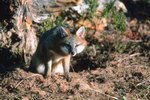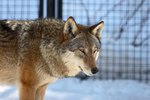
The several adaptations of arctic foxes (Vulpes lagopus) have allowed them to play an integral role in the tundra biome. These small predators rely heavily on both abiotic and biotic factors in their harsh environment; changes to either would greatly impact the arctic fox's behavior and, possibly, the species' survival.
Abiotic Vs. Biotic Factors
An ecosystem is formed within a biome based on the relationship of the abiotic and biotic factors within the area. Abiotic factors are non-living factors in an environment. Light, temperature, water and nutrients are all abiotic factors that greatly affect each ecosystem. Biotic factors, on the other hand, are the living factors in an ecosystem: animals and plants. Without the abiotic factors such as the soil and sun, the plants and animals would cease to live.
Camouflaged Foxes
Arctic foxes rely on the abiotic factors of their environment to camouflage themselves in different seasons. During the winter, the tundra is covered with snow and ice and the wind whips through at high speeds. Their winter coat is thick and dense and snowy white, which helps them blend in with their surroundings and keeps them warm. During the short summer, the tundra snow melts and the land is covered with rocks. Artic foxes lose much of their dense fur as their coats turn a brown or silvery color that blends in with their environment.
Free Freezer Space
During the summer, arctic foxes have numerous prey options because rodents and rabbits are plentiful. The foxes use this surplus in prey as an opportunity to stock up on food. The foxes will hunt and bury their prey under cold rocks which keeps the meat cold and prevents spoilage. This practice secures at least some food for the season for both the adults and their young. The male fox will hunt and bring food back for the female and their pups and then bury any excess meat.
Home Sweet Cliff
The tundra biome is characterized by harsh weather and a rocky landscape. Arctic foxes use the rocky landscape, an abiotic factor in their environment, for protection against predators and the weather. They dig their dens in rocky or sandy areas, typically on cliffs with a southern exposure. The dens are used as protection for the families of foxes and often have several entrances.
References
Resources
Photo Credits
-
Jupiterimages/Photos.com/Getty Images
Writer Bio
With a professional background in gardening, landscapes, pests and natural ecosystems, Jasey Kelly has been sharing her knowledge through writing since 2009 and has served as an expert writer in these fields. Kelly's background also includes childcare, and animal rescue and care.




